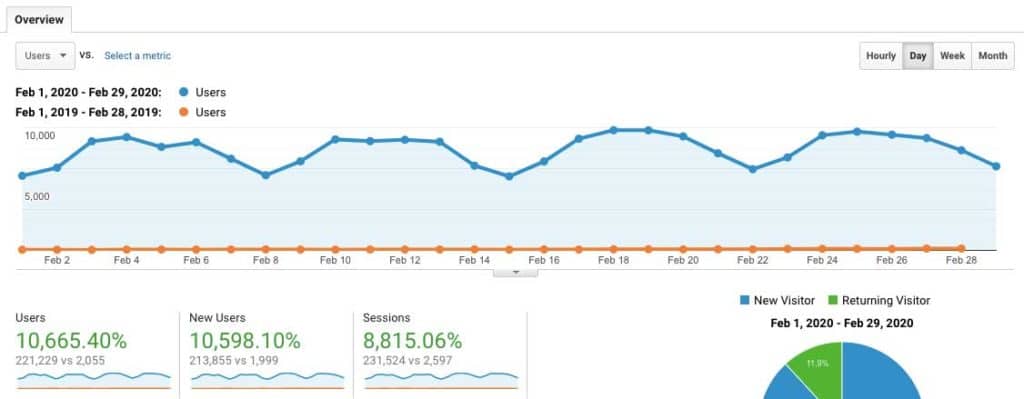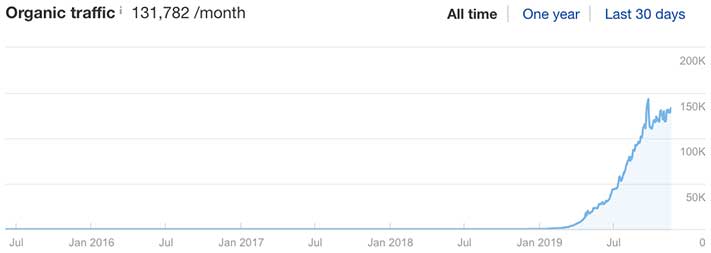How To Add A Guest Blog To My Blog
If you just started a blog this year, you're entering the most competitive search engine landscape in history. If guest blogging isn't a part of your marketing strategy, you are severely limiting your growth.
It's not 2008 anymore – you can't hit page 1 on Google just by plopping down 500 words on a page or joining some shady backlink directory. You need to up your game.
High quality, long-form, media-heavy, and relevant blog posts with backlinks are what rank this year. (Gee, thanks for making us work harder, Google.)
And excluding on-page SEO, getting high quality, relevant backlinks from high Domain Authority sites are more critical than ever. So how do you get the most high-quality backlinks this year?
The answer is modernizing and scaling your guest blogging strategy.
To test the effectiveness of guest posting, I implemented a 15-day guest blogging experiment.
My goal was simple:
In 15 days, publish as many guest posts as possible on high Domain Authority sites to learn four key things:
1. How to master the guest blogging process.
I wanted to learn the ins and outs of how to effectively target influential blogs, perform email outreach, pitch topics, write and edit drafts, and get published on high DA sites as quickly as possible.
2. The impact of a guest blogging strategy on a website's SEO this year.
Once the 15 days end and any articles are published, I would use SEO tools to understand how effective guest posting was at increasing Domain Authority, Alexa Rank, and driving target organic traffic.
3. Strategies to scale white hat SEO this year.
Black hat SEO strategies have been out of style for over a decade now. I wanted to discover the best ways to scale white hat SEO techniques and accelerate the acquisition of trustworthy, authoritative links.
4. If anyone, regardless of experience, can get high-quality backlinks.
In my guest blogging experiment, I only targeted websites with a Domain Authority of 60+, with the average being 72.5. I wanted to prove that any new blogger can obtain these high-quality backlinks.

Source: vecteezy.com
Disclaimer: Please note, this article includes affiliate links which may provide me a commission at no cost to you. These are merely the best online jobs and the tools to use to be successful. You can read my affiliate disclosure in my privacy policy.
Table of Contents
My Guest Blogging Experiment: 15 Days, 18,400 Words, and 8 Guest Posts
My guest blogging experiment began on January 4th, 2019, and ended on January 18th, 2019. During these 15 days, I went through every step of the guest blogging process. This process included finding the right contacts, cold email outreach, pitching topics, outlining and writing drafts, and finally, submitting guest posts to get them published.
On January 4th, I started emailing 68 different websites to ask if I could contribute a guest post. Of these 68 sites, 28 were interested. Of these 28, I pitched topics to 18. Finally, of these 18 sites, I got eight articles published in 15 days.
In fact, on the last three days of the experiment – January 16, 17, and 18 – articles were published three days in a row.

January 16, 2019: StartupNation (DA 61)

January 17, 2019: AddThis (DA 94)

January 18, 2019: Infusionsoft (DA 84)
Now that my 15-day guest blogging experiment is over, I can safely review the data and assess the SEO impact on my blog.
Here are the results:
- Eight guest posts published on websites with Domain Authorities of 81, 73, 60, 66, 71, 61, 94, and 84
- 32 new referring domains
- 247 new backlinks
- 268 new organic keywords ranking in the top 100
- 372% increase in organic traffic
- +12 to Domain Rating
- Alexa Rank improved by 600,000
I'd say the guest blogging experiment was a success!
This blog post is your ultimate guide to unlocking everything I learned after 15 grueling days of aggressive pitching, writing, and publishing guest posts.
Update (March 2020): By continuing this process over 12 months, I wrote over 80 guest posts in 2019, increased my Domain Rating from 0 to 76, increased my organic traffic from 0 to 300k+, and started making $61k/month from this blog – see my Blog Income Reports.

Let's get started.
If you still need to start a blog, you can get started with Bluehost for $2.95/month (63% off).
What is Guest Blogging?
Guest blogging is the process of a blog owner, writing a guest blog post on another website's blog. Guest bloggers offer to write content for other blogs in their niche, with the benefit of increased backlinks and referral traffic.

Source: optinmonster.com
What are the Benefits of Guest Blogging?
If you ever hit publish on your latest blog post, wait anxiously for readers, and then.
*crickets*
You're not alone. Since it takes time for your blog posts to move up the organic search rankings, it gets discouraging when you don't see traffic right away.
Writing guest posts is one of the best ways to boost these rankings and build your credibility. By leveraging other blogger's audiences and Domain Authority (DA), you build up your backlink profile and gain exposure to a broader audience.
Here are my top benefits of guest blogging.
1. Building Your Domain Authority
Your Domain Authority (DA) is a search engine ranking score (from 0-100) that predicts how well a website will rank. Domain authority is a metric created by Moz and measured by many factors, including the total number of links, linking root domains, social signals, TrustRank, and more into a single score.
One of the best ways to build a Domain Authority is by guest posting. When you contribute content to other blogs, you can include a link or two to your website. Obtaining these contextual, dofollow links from high DA websites is one of the best ways to increase your website's domain authority (and traffic).
2. Getting Valuable Backlinks
Backlinks, also known as dofollow links or inbound links, are links from other websites to your website. Sites like Google consider backlinks a vote of confidence from the referring domain, boosting your website's credibility in their eyes.
These backlinks are like votes – the more you get, the more search engines believe your content marketing efforts are credible, useful, and valuable.
When writing guest posts, you can add a link or two to your own site within the content, and you can also link to your site in your guest author bio.
3. Generating Referral Traffic
In addition to obtaining backlinks and SEO benefits from writing guest posts, your backlinks also bring in referral traffic. A user reads your guest post and clicks links back to your blog, increasing your traffic.
When writing a guest post, strategically add your backlinks to URLs that you want people to read – a useful article, opt-in email page, or service page.
4. Creating New Relationships with Bloggers
Ultimately, the most important benefit of guest blogging is the new relationships that you build with other bloggers and influencers in your niche.
It's a very collaborative blogging strategy, and you'll most likely stay in contact with site owners long after your post is published.
The key is to be valuable. Respond kindly and promptly to emails, send in your drafts on time, and most importantly, create fantastic content. By doing these things, you'll have a better chance of maintaining a healthy relationship.
Finally, these relationships can also turn into further guest blogging opportunities down the road. Additionally, you can leverage your connections and turn them into other cool projects like co-marketing, podcasts, ebooks, and online courses.
You can also use these relationships to get intros to more influential guest posting opportunities.
How to Pitch Guest Posts to High Domain Authority Sites
1. Start By Understanding Your Value
Before you get started on your journey, there's one central theme you need to understand.
You have to provide value.
Don't go into the process of guest blogging for SEO only thinking about what you'll get out of the deal. First, you need to focus on the benefits you'll give the site.
Ask yourself: what value are you providing?
- Does your expertise match their audience's interests?
- Does your writing style match what the blog's audience is looking for?
- Is the blog currently in need of a lot of content to fill their editorial calendar?
- Can you leverage link building for them in other guest articles you're writing?
- Is there a topic that you're well versed in that doesn't exist on their blog?
The first step in pitching and finding blogging opportunities is understanding your value and what you can do to help. This information will be vital in your initial email outreach strategy.
2. Create a Targeted List of Websites You Want to Write For
Once you understand the value you can provide, it's time to start building your blog outreach list.
This list should be a simple spreadsheet with five columns: Website, Name, Email Address, Status (you'll note your outreach dates here), and Notes.
To start populating your spreadsheet with guest blogging sites, look up the target blog's monthly site visitors and Domain Authority by plugging their URL into an SEO tool like Ahrefs.
Aim for blogs with a Domain Authority of 50+. Also, check to see if their blog is hosted on their main domain or subdomain – oftentimes a blog on a subdomain won't provide as backlink strength as a blog on a root domain.
Remember, the higher the Domain Authority, the more SEO impact you'll receive from each backlink. Additionally, the higher their monthly site visitors, the more readers your guest post will get.
If you're new to blogging, it may not make sense to reach out to a site like Forbes or The Huffington Post, as those require real-world relationships and connections.
Aim for websites in your niche with Domain Authorities above 50. To save time during your search, find an article featuring the top blogs and websites accepting guest posts, with Domain Authority scores added in.

Source: websitehostingrating.com
But just traffic levels aren't enough – you need to look for engagement as well.
A WordPress blog with 1 million visits/month, but few comments, Tweets, or social shares could be less valuable than a site with 50,000 visits/month but a highly-engaged audience. You want readers to interact with your content, so look for engagement.
You can also research and find the website's email subscriber list size. A quality guest article may be shared to their subscribers after it is published, boosting your visibility.
Once you are done adding blogs to your spreadsheet, research these sites in-depth to find their guest posting guidelines. A lot of blogs have a dedicated page that outlines exactly how to contribute, what they are looking for, and requirements on tone, word count, and more.
To find these guest post guidelines, do a quick Google search like: "site:blog.com blog guidelines." This searches the blog for any content related to their guest post guidelines.
When you start guest blogging, avoid sites that require a full draft submission via a contact form. You don't want to put in hours of work writing a 2,500+ word article, only to submit it via a form and get no response. Focus on sites that allow you to pitch topics or outlines.
3. Find the Right Person to Contact for Guest Blogging Opportunities
So you've pared down your list of blogs based on the criteria above. It's time to find the right person to contact.
First, use LinkedIn.
Start by filtering your search results by the blog's company page, then within the company, search for people by using terms like: "Content Manager," "Blog Manager," "SEO Manager," "Editor," or simply, "Content."
After you find 2-3 potential contacts, connect with them on LinkedIn. Remember, 2nd degree LinkedIn connections are better than 3rd, and if you have a mutual contact, even better.
Don't spend too much time on your connection message either, often your text gets buried or comes off as spammy.
You can also use social media to reach out on Facebook. Find the company or blog's business page and send them a short message. Companies are likely to respond to Facebook messages because they want to maintain their "quick to respond" metrics on their Facebook pages.
Once you've reached out on social media, use a tool like Hunter.io or ContactOut to find the right contact's email addresses. Even if you can't find their exact email address, a tool like Hunter.io shows email structure, such as firstname@blog.com or firstname.lastname@blog.com.
ContactOut has a helpful Chrome Extension that works on top of LinkedIn and adds people's email address, phone, and social media channels:

Finally, to stay on the cutting edge with your outreach strategy, check out Respona. They are creating an all-in-one search, outreach, and engagement platform that's launching very soon.
Using AI, they are planning to be the most comprehensive solution to find content, get contact information, and send dynamic email templates. You can join their early access beta list to test them out before they launch.
Once you have this information, add it to your spreadsheet, and note the date of your attempted LinkedIn connection.
4. Start your Guest Blogging Email Outreach
To recap your progress so far, you now have your list of blogs you want to write for, the correct person to contact, and connected with them on LinkedIn. Now it's time to start your guest post email outreach strategy by using templates and personalized messaging.
There are plenty of cold email strategies out there. The best tips I learned are to keep your email short, provide value, and showcase your previous work.
Here's a cold email template that I like to use, with an 80%+ open rate and 50%+ response rate:
Subject Line: Hey (First Name) // Content and Link Building Opportunities – Adam from (Company)
Hey (First Name),
My name's Adam and I'm the (Job Title) at (Company).
I'm reaching out because I love (Target Blog) and your (Target Article) really resonated with me because (Reason).
I was curious if:
1) You'd like to participate in link building. I write (X-X) guest posts per month and would be happy to link to your site in my content.
2) You allow guest posts on your blog.I'd love to contribute to your (awesome? informative? useful?) blog and can pitch some topic ideas that I think your audience will enjoy. Here are some recent samples from me:
(Sample 1 URL)
(Sample 2 URL)
(Sample 3 URL)Please let me know if you're interested and I look forward to hearing back from you soon!
Thanks,
Adam
That's it – and this one is a little bit on the long side. In the end, it's about treating each person as a friend, personalizing your content, providing value in the form of links, and getting right to the point.
Email outreach gets much easier over time once you have a large sample of content and start getting your articles noticed. If you don't have any writing samples published just yet, have a few drafts in your back pocket that you can share. As a last resort, share a link to your blog.
If you receive an email response and they are interested congratulations! The next step is pitching your topic ideas. Sometimes you'll receive guidance on topics or themes the blog is looking for, but more often than not, you'll have to come up with a topic on your own.
5. Perfecting Your Topic Pitch
There are four main criteria for the perfect topic pitch:
- Your content doesn't exist on their site yet. When you have a guest post idea, go to Google and search "site:blog.com topic" to scan their blog to check if it already exists.
- Your topic and target keywords have SEO value. Go back to Ahrefs and input the blog's URL. View which organic keywords are driving the most traffic to see if you can find gaps in their content that you can fill.
- The topic matches your expertise. You should be able to write intelligently about the topic and use the guest blog to build more influence in your niche.
- The topic matches the audience's interests. Check their editorial guidelines and look into how they write their headlines. Then read a few of their blog posts to understand better what kind of topic and titles will match their visitors' interests. You can also check out which of their articles are the most shared on social media to see the content that works best.

Source: makeuseof.com
After your research is complete, and you have 2-3 ideas, share them promptly. You can also note in your email reply that, "if these topics don't work for your audience, I'd be happy to send over more ideas." In most cases, (if you've done your homework) one of your topics will be approved for a draft.
It's time to start writing.
Remember, if you still need to start a blog, you can get started with Bluehost for $2.95/month (63% off).
How to Scale Your Guest Blogging
Before you start clicking away at your keyboard like a modern-day F. Scott Fitzgerald, slow down and consider your options. There are two questions to ask yourself:
- Are you going to write the drafts yourself?
- Or can you outsource some of the drafts to content writers?
Wait a second.
After all of this research, outreach, and pitching,I'm not going to write the actual blog post?
The answer: not necessarily.
1. Work With a Content Company, Freelancer, or Guest Blogging Service
If you think that the credited author always writes guest posts, you're sadly mistaken. The typical blog post takes 3.5 hours to produce (and that number balloons up to 10+ hours for longer content). It may be a better use of your time to get a ghost blogger to write the content for you.
If you own the topic idea, create the blog post outline, and edit the final draft, working with a bylined guest post service or hiring a freelancer can save you time and scale your process.
76% of people surveyed in a Public Relations Journal Study believe that as long as the idea came from (and was approved by) the stated author, ghost blogging is just fine. With some ghost bloggers writing hundreds of articles per year, these backlogged articles need a home.

Source: culturevulture.com
By outsourcing specific components of the guest blogging process, more of your time is freed up to pitch topics, send in more drafts, and publish more articles.
The perfect way to scale your guest blogging strategy is to separate portions of the process to different individuals.
Here's how it works:
You, the author, pitch the topic, create the outline, and handle the emails. In unison, your writer pens the initial draft, inserts their links and sends you the finished draft. Then you revise the copy, add your links, and submit the draft.
Since high Domain Authority links are so valuable, if you're great at pitching top DA sites (think 70+), you may be able to get content cheap or even free if you allow your writers to add their own backlinks into your articles.
Amazing.
You can find competent freelance writers on sites like Flexjobs.
I placed a featured job posting on the ProBlogger job board and got over 60 freelance writing applications in one day.
2. Create High-Quality, Shareable, Long Form Guest Blog Posts
The quickest way to make your guest posts go viral on social media is by creating unique, high-quality, linkable content. What do I mean by linkable?
Well, if you hit publish on a guest post about the Top 10 Digital Marketing Trends, but it has no useful data or images, it's probably not going to get shared.
Alternatively, if your article is filled with interesting stats to back up your claims, beautiful infographics, and striking imagery, it is much more likely to go viral and generate passive backlinks.
3. Format your Guest Blog Posts and Links to Maximize Effectiveness
Primarily, guest post drafts are written, shared, and approved all inside of Google Docs – a free tool that's perfect for collaborating with bloggers.
There are a few best practices to understand: formatting rules, sharing options, and link strategies to maximize your effectiveness per post.
A. Format Your Google Doc Correctly
Nothing will make you look more like a rookie to another blogger than not understanding how to format your drafts. Every blog has slightly different guest blogging guidelines.
However, using the Outline Tool within Google Docs will help make your draft easier to navigate and feature the correct headers (H2, H3, H4, etc.).
You also want to understand Google Docs sharing rules. Send your drafts to editors with the share setting of "Anyone with the link can edit." If you're paranoid your precious work will be edited into oblivion, make a copy and save it to your Google Drive.
Make sure to also include any images in your document if necessary. These can be stock photos, but are usually screenshots of websites. If you use screenshots, make sure to cite the source URL underneath and add alt text to the image.
B. Strategically Add Your Links
Typically, when writing a draft, you're allowed to add 1-2 links to your website within the content. Plus, you get a link to your homepage in your author bio. But these aren't hard and fast rules.
For some guest posts, you might be able to get away with adding 3-4 links to your website in the content. The key is your links need to be contextual, relevant, and highly useful to the reader.
Also, mix up your anchor text so that your backlinks don't send traffic to your site with the same keyword every time. This is not an SEO best practice.
When placing your links, start by adding at least two within the content, unless the guidelines explicitly state otherwise. Your links should go to blog posts that are relevant and backup the content, not your home page or contact page.
Bonus tip: some blogs are re-syndicated to multiple international TLDs, so one link can potentially count as ten if the website has separate international domains.
C. Add Your Author Bio (With Backlinks)
An effective guest author bio is 2-4 sentences long, gives readers a feel for who you are, what you do, and a way to connect with you. And you're not limited to just one backlink in your bio. You can usually get away with two (I've had a few posts with four).
Another tip is to strategically link to an opt-in email page from your guest author bio to get more subscribers for your list.

Here's a bio of mine from my guest post on Crazy Egg with two links in my author bio:
4. Link to Target Influencers in your Guest Posts
When placing links, don't solely focus on yourself – share the wealth!
Links are the currency of the Internet. A recent survey in 2018 found that 78.6% of blogs sell links, with an average cost of $352.92 per link. And this number is rising.
The going rate for a link from a 90+ Domain Authority site can go for as much as $2,500 per link.
Another benefit of guest blogging on high DA sites is that you can leverage this DA to provide value to influencers. For example, if there's an influential blogger, podcaster, or celebrity you have always dreamed of rubbing shoulders with, link to their website in your guest posts frequently.

Source: exob2b.com
Better yet, use an SEO tool like Ahrefs or SEMRush to find specific landing pages where they're ranking between 5-15 for a high volume keyword. Link to that landing page from your top DA guest posts multiple times to see if you can boost their rankings.
Once you link to the influencer 5-10 times, reach out to them via email. Let them know you love their work, showcase the useful links you've sent them, and don't ask for anything in return.
What? Ask for nothing in return?
Yes, that's correct.
The best way to grow your online influence with guest posts is to provide incredible value to the most substantial amount of people, with zero expectations.
If you can become influential and provide real value to real people, people will organically want to help you.
Become so valuable that others feel bad if they don't help you out.
Okay, now that all of your influencer links are placed, it's time to submit your draft. Send your guest post submission and wait for feedback. The editing process is usually relatively quick. In this stage, you can collaborate further inside your Google Doc and answer any comments or suggested changes they may have.
Once the draft is approved, your article will get a scheduled publish date – typically 2-3 weeks out.
You've made it a long way, and your guest post is scheduled. Let's recap what you've done so far.
- First, you discovered how you could personally provide value to other bloggers.
- Next, you created a targeted list of blogs you want to write for, focusing on Domain Authority, traffic, and engagement levels.
- You uncovered the right contacts and performed email outreach with a reusable email template.
- After receiving a reply, you sent a guest post pitch after scanning their site and understanding their audience.
- Once your topic was approved, you started writing and formatted your draft correctly in Google Docs.
- Next, you strategically placed your backlinks in your content and guest author bio.
- As a bonus, you linked to influencers and people you want to work with.
- Finally, you submitted your draft, assisted with edits, and locked in a publish date.

Your article is officially ready to launch.
Do you still need to start your blog? Try Bluehost for $2.95/month (63% off).
5. Guest Blogging for SEO: Tracking your Results
Congratulations! Your guest post's publish date has arrived, your article is posted, and you get to read your published work on a popular blog. Take the time to enjoy this moment – your hard work has paid off.
So what do you do now that your article is live? (What?! There's more?!)
Share your article on your social channels and among your professional network. Once the article has been up for a week or two, it's time to recognize the SEO impact this article has on your website. Remember, you have to be patient.
It takes time for sites like Google's PageRank to discover your guest post, crawl its links, and attribute them back to your website. And it takes even longer for these links to impact your search rankings.
Much like submitting your site to Google Search Console (formerly Webmaster Tools) isn't instant, the same is true for your guest posts.
But after patiently waiting, crawlers hit your article, discover your new backlinks, and recognize the new referring domain pointing to your blog. Let's track your SEO progress.
Use a tool like Ahrefs (if you haven't realized already, I love this tool) and check the following website metrics to view their improvements over time.

Source: ahrefs.com
1. Alexa Rank.
The measure of a website's popularity. It ranks millions of websites in order of popularity, with one being the most popular. Your Alexa Rank is a great metric to track, as it compares the popularity of your site against all others.
2. Domain Rating.
Similar to Domain Authority, Domain Rating is a KPI created by Ahrefs which measures your website's authority on a scale from 0-100, based on your link profile.
3. Number of Backlinks.
You can view the number of new, lost, and live dofollow links that are pointing to your domain. This number includes multiple links per domain, so if you get four links in one guest post, the total number of backlinks is 4.
4. Number of Referring Domains.
This SEO metric is similar to your amount of backlinks, except that it is only counting the number of websites linking to you, not your total number of links. Based on the previous example, if you receive four links from one guest post, the total number of referring domains is 1.
5. Organic Keywords.
Once you crack the top 100 search results for a target keyword, you can track its progress and movements in Ahrefs.
It's important that your number of organic keywords increases over time, as new backlinks to your blog posts will increase their visibility and rankings on Google.
Track these results every week (or every day if you're obsessed like me) and enjoy witnessing the impact of your hard work.
Guest Blogging FAQ.
Does guest blogging work?
Yes, guest blogging still works and is a viable way to build relationships with other bloggers, get in front of a new audience, build your blog's reputation and improve your SEO.
When I launched my blog in 2019, I wrote over 80 guest posts in the first year and it drastically improved my SEO and traffic. I grew my Domain Rating (DR) from 0 to 76, increased my traffic from 0 to over 300,000 visitors/month, and started making over $60,000/month as you can see in my Blog Income Reports.
If you want a step-by-step guide on how to start a blog with startup growth tactics to make money faster, check it out here.
Do guest bloggers get paid?
In general, most guest bloggers do not get paid and write for other sites to build relationships and get backlinks for their blogs. Some sites that are in need of content and have a pool of writers can pay you for your guest posts, but typically require you to write a certain number of posts over a period of several months.
Alternatively, some sites may charge you to write a guest post for them in the form of a sponsored post. Prices can range from $100 to $2,000 but the normal price range for a sponsored post is somewhere between $250 and $750 based on the blog's traffic and reputation.
Should I accept guest posts on my blog?
There are pros and cons to accepting guest posts on your blog. On the plus side, you get to publish free content that you don't have to write which can increase the number of articles on your blog and increase your traffic.
On the downside, you need to be cautious when you start accepting guest posts. Create strict editorial guidelines and make sure that the content is high-quality and doesn't include low-quality external links.
Is guest blogging good for SEO?
Yes, guest blogging is good for SEO as it helps your blog obtain backlinks and referral traffic. These dofollow links pass SEO value from the guest post site to your blog via the links you add. This builds up your Domain Authority (DA) over time which helps you rank faster on search engines.
Keep in mind that you should be careful with both the sites you choose to guest post on and how you add your links to the articles. Look for reputable, quality blogs to write for that have a strong DA and high-quality content in your niche.
Additionally, when adding links to your blog within your guest posts, make sure to optimize your anchor text. You should mix up anchor text and make it as natural as possible so that it flows well in the content and provides additional value.
Your anchor text also shouldn't be over-optimized or always match the exact keyword your blog post is targeting. Mix it up with phrase-match anchors (contains the target keyword + additional terms), branded anchors (your blog name), and even some anchors without your target keyword at all.
How many links should a guest post have?
The number of external links in a guest post is based on the individual sites editorial guidelines. A good rule of thumb is to include 3-5 links for every 1,000 words of content. Make sure to include 2-3 links to your own blog within the content so that you gain SEO benefits from the post.
My Guest Blogging Experiment: Summary
Guest blogging is still one of the best ways to grow your web traffic over time. By writing high-quality guest posts on other websites in your niche, you receive valuable inbound links, increase your Domain Authority, gain more exposure to readers interested in your content, and build new relationships with bloggers.
To get started, discover the value you can provide to other bloggers. Use email outreach strategies to lock down guest posts. Leverage content writers to scale the speed at which you publish.
Build enough influence to get people to write for you. Finally, maximize your SEO impact with smarter link placement.
By conducting my guest blogging experiment and publishing eight guest posts in 15 days, I received 247 new backlinks, a 12 point boost to my Domain Rating, and a 372% increase in organic traffic.
Then I took that initial experiment and published over 80 guest posts in one year, improved my Domain Rating from 0 to 76, increased my blog traffic from 0 to over 300,000 visitors/month and started making $61k/month.
Now it's your turn.
If you're ready to start a blog, get started with Bluehost for $2.95/month (63% off).
With thousands of websites accepting guest posts from seasoned writers and new bloggers alike, it's time to up your game.
So go out there and build your online influence, scale your content strategies, and provide so much value that influencers will be asking you for help.
Continued Reading on AdamEnfroy.com: If you want to take your blogging further, check out my ultimate guide to starting a blog, ways to make money blogging, and the best web hosting companies to get started.
How To Add A Guest Blog To My Blog
Source: https://www.adamenfroy.com/guest-blogging
Posted by: higginbothamfacking.blogspot.com

0 Response to "How To Add A Guest Blog To My Blog"
Post a Comment